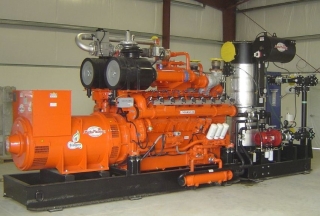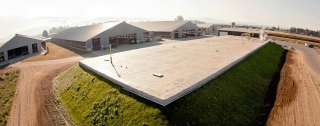|
Subscribe / Renew |
|
|
Contact Us |
|
| ► Subscribe to our Free Weekly Newsletter | |
| home | Welcome, sign in or click here to subscribe. | login |
Environment
| |
 |
September 26, 2013
Dairies struggle to balance business and the environment
Landau Associates

Easterson
|
Peer through the lens at some of the environmental challenges facing our state and you might be surprised to find the doleful eye of a cow staring back.
Increasingly, dairy owners are being tasked with minimizing the impact of their farm management practices on the environment, which includes nutrient management to avoid pollution of ground water and surface water, preventing pathogen contamination of water resources and managing air quality issues.
The majority of the state’s dairies are family-owned, often a legacy industry with the current generation challenged with implementing appropriate stewardship while maintaining economic viability.
Washington ranks 10th in total milk production among the 50 states and is home to more than 450 dairy farms caring for approximately 262,000 dairy cows. Wander down the aisles of any grocery store and you can’t help but notice the amount of space reserved for milk, cheese, yogurt and ice cream, so it is no surprise that dairy foods constitute the second largest agricultural commodity produced in Washington, contributing an estimated $3.2 billion to the state’s economy.
Changing landscapes
The first cows came to Washington in 1838 and for more than a century dairies were primarily small entities that relied on hand labor for the exhaustive care required to run a milking operation. With the advent of technology, dairies were able to care for larger herds and thus meet the demand for milk and dairy products from a burgeoning population.
Over the past 50 years, the structure of agriculture has changed, moving toward specialization and concentrations of crop and livestock production. While this change revolutionized the consumer’s ability to readily find grains, meat and dairy products, it also migrated nutrients from crop-producing regions to areas of high concentration of livestock.
Nutrients from crops, or feed, are exported from a livestock operation in the form of meat and dairy products but animals such as dairy cows don’t use all the nutrients they take in, instead passing them along in nutrient-rich manure. A 1,400-pound dairy cow produces approximately 120 pounds of wet raw manure a day, and over time the buildup of nitrogen and phosphorus can increase the risk of these nutrients leaching and impacting water quality.
Regulatory agencies began to address issues associated with concentrated livestock operations under the Clean Water Act in 1998 when the U.S. Drug Administration and the Environmental Protection Agency initiated public meetings to draft the Unified National Strategy for Animal Feeding Operations.
From inception, the regulations governing the National Pollutant Discharge Elimination System and the Effluent Guidelines for Concentrated Animal Feeding Operations (CAFO) have undergone a number of changes in order to strike a balance between what is practical and what will be effective. As recently as March, the EPA was soliciting public comment as part of a 10-year review process for regulations that have or could have a significant economic impact on a substantial number of small entities, such as family farms.
In Washington, nutrients and wastes from dairy and other livestock operations are regulated by programs administered through the state departments of Ecology and Agriculture. The CAFO general permit requires owners of concentrated livestock operations, such as diaries, to manage manure waste in a manner that avoids polluting waters of the state, including rivers, streams, lakes and underground aquifers.
Water quality is not the only environmental challenge facing dairies; air quality issues associated with animal agriculture include the emission of ammonia, methane and odorous compounds. In 2009, the EPA enacted new reporting requirements for air releases of hazardous substances from farm animal waste, requiring farms with more than 700 mature dairy cows, whether milked or dry, to report any releases of anhydrous ammonia greater than 100 pounds in a 24-hour period.
Not all black and white
Holsteins, with their familiar black-and-white hide markings, are by far the most common breed of dairy cow, but complying with the environmental regulations governing dairies is not so black and white. In general, dairy farmers are quick to point out that they are dependent on the land and take strong measures to be good stewards.
As one Washington dairy farmer put it: “We live on this land. We breathe its air. We drink its water. We eat the food grown from its soil. Are we really going to abuse that which keeps us alive?”
Dairy farmers employ a wide range of environmental management practices, ranging from manure management and storage plans to high-tech systems that convert cow manure to electricity. Many farmers serve on local groundwater management boards and as an industry are quick to seek university researchers or technical expertise to improve ways for managing farm waste and odors.

Since 1998, dairy owners have spent millions of dollars installing lagoons and other nutrient management technologies to comply with the state’s Dairy Nutrient Management water quality program. Still in the vast landscape of mixed land uses, crops, industry and expanded housing, the dairy industry is the only entity that is regularly monitored for compliance for nutrient management.
Recent litigation involving a handful of state dairies has raised questions about establishing accurate measurements of impacts to the environment from dairy operations. While nutrient discharges are monitored from dairies and other CAFOs, other contributors of nitrate contaminants can include septic tanks and drain fields, commercial fertilizers and other farming practices not regulated by discharge permits.
Compounding the issue of measurement accuracy is that nitrogen is a natural compound of almost all soils and determining the amount of appropriate nitrogen uptake is affected by ever-changing soil temperatures, bacteria levels and soil moisture levels. Dairies and CAFOs are required by their CAFO general permit to include a lagoon leak detection program as part of their nutrient or manure management programs, but there is no standard process for making these determinations. Only recently has an informal interagency livestock technical advisory group formed to develop guidance for leak detection.
Air quality regulations impose similar challenges. The amount of ammonia and hydrogen sulfide released from CAFOs will vary depending on feed, temperature and the type of confinement and manure handling, so understanding when and how to calculate air releases is left up to the owner/operator to perform in “good faith” and to the best of his ability.
Bovine biogas
Some of the state’s dairy owners have invested in methane digester technology, a process that converts manure into methane-rich biogas used to generate electricity on the farm and even produce excess that can be returned to the energy grid. This strategy for waste management helps with both water and air quality, but has not been adopted widely because the cost of constructing and maintaining these systems can exceed the value of the benefits.
Current studies being conducted by the University of Wisconsin-Madison and University of Wisconsin-Extension are helping East Coast dairy farms reduce greenhouse gases and will eventually be combined with other new technologies to provide life-cycle assessments of dairy cows. These studies aim at providing tools for dairy farmers to better tally the total environmental impact of their industry.
Like business owners across the spectrum, dairy farmers seek modernization and efficiency to meet the bottom line and provide for product demand. Dairy products enjoy a high degree of consumer confidence for safety and nutrition and buyers often equate dairy consumption with strong bodies and strong bones.
Perhaps missing from the consumers’ viewpoint is the current struggle for diaries to sustain a strong economy while being tasked with maintaining a strong environment.
Cindy Easterson is a senior marketing coordinator with Landau Associates, a firm that specializes in environmental and geotechnical engineering, environmental permitting and natural resources consulting. Landau Associates has offices in Edmonds, Seattle, Tacoma, Olympia, Spokane and Portland.
Other Stories:
- Wastewater plant cleaned up for the 21st century
- What’s next in green building? Seattle has it
- Surveys 2013: Plauche & Carr LLP
- Surveys 2013: Optimum Energy
- Surveys 2013: GeoEngineers
- Surveys 2013: Cascadia Consulting Group
- Surveys 2013: Hart Crowser
- Surveys 2013: Innovex Environmental Management
- Surveys 2013: Shannon & Wilson
- Lower your energy bill by 75% with a Passive House
- Murky floodplain rules sink development plans
- Is your data center as green as it can be?
- Protecting Puget Sound’s marine shorelines
- At the UW, smart grids put a lid on energy use
- Rising sea level threatens Port Gamble tribe
- Surveys 2013: Ridolfi Inc.



